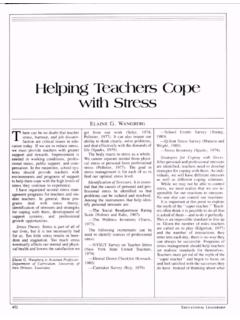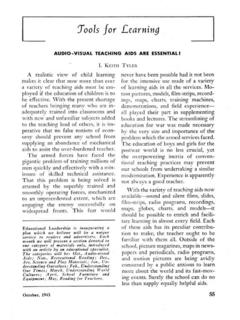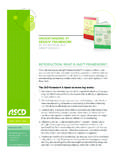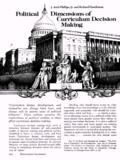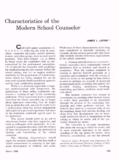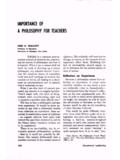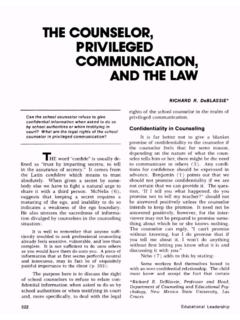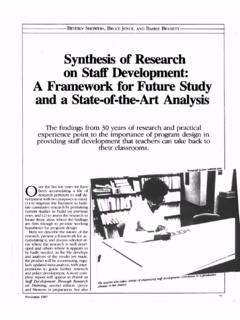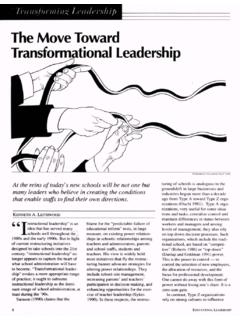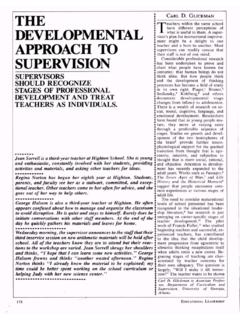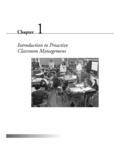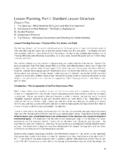Transcription of Instructional Supervision - ASCD
1 F ~ =p t ~ =a t ?f ~ = = ~ = = = =~ = = =~= ~ = I= ~ = ~ =~ ~ = I= = = = = = =~ = K?The dilemma of Instructional Supervision is a self-created crisis caused by lack of definition, lack of exercise, and lack of a legitimate compre hension of the current social dissatisfaction with the schools and Supervision has been narrowly considered as the observation of a performer (teacher) by a generally-agreed-to-be-excellent performer (supervisor). The excellence of a su pervisor rests upon having proven teaching ability and proven mastery of notion that a supervisor is to be more than a "helper," that indeed the supervisor has some role in making educational theory into edu cational programs and processes, is accepted by some progressive school systems. The concept that a supervisor must also translate community- generated goals and processes into programs is practically nonexistent.
2 Herein lies the definition dilemma for community involvement in instruc tional , as described in contracts by systems that have collective bargaining agree ments, are those who must be involved in the "axing" process; that is, ousting teachers not per forming satisfactorily. The disaster is not that a satisfactory rating is based on the supervisor's personal perception, but that an unsatisfactory rating does not allow for a supervisor being out of synchronization with community input. It is as though the schools are the exclusive province of educators and school boards, at least as far as the functionaries are concerned. Unless the su pervisor has internalized community expectations of product/process, those teachers labeled as suc cesses could be succeeding in the wrong processes in relation to the wrong educational under the direction of a Central School System are more prone to operate as per- petuators of what was and is, rather than what is to be or should be.
3 Indeed, supervisors are often those who have "earned their stripes" as teachers and/or second-level administrators. It is unheard of for the supervisor to be a newly trained, newly educated, or newly assigned spe cialist from the academic or professional "field."MAY 1977589 Seldom is the supervisor selected or screened for community awareness and participation. Part of the requisite seems to be internal motivation, in ternal operation, and internal commitment. Sec ondary loyalties often are to those publishers of commercial materials and their representatives who make social and financial agreements for editing, promoting, using, and recommending their products, regardless of appropriateness and need-satisfying or cost-effective considerations. In short, both performance of Central Office su pervision and content by way of materials and activities are likely to be prepackaged, predeter mined, and , let us introduce new or intervening elements into a traditional system a switch from a predominately white to a black population, a decentralized school system, a student boycott, a teacher strike, an outcry against illiterate or semi-literate graduates.
4 What do supervisors do? What can they do?The clients of the supervisors, that is, un satisfactory or marginally satisfactory teachers, are not likely to race to the defense of the super visor. The publishers are probably also under attack and will bypass the system until "things return to normal." Top administration is looking for a scapegoat group that doesn't lead to geno cide, and the supervisory pool is expendable. Voila! The supervisor is the target, the victim, and the villain!Given the case of the supervisor/translator, what differences would be operative?First, if the supervisor had been personally and consistently involved with the visible commu nity in agreement/retraining, definition/redefini tion at the community level would have occurred. The supervisor, with teachers, would have devel oped programs, procedures, selected materials, de veloped internal teaching strategies, piloted ac tivities, and given and received mutual encourage ment and support.
5 At this point, community goals become visible in the classroom. The community joins the supervisor and teacher in promotion and revision of the embryonic programs, and they all "buy-in" to a common product, a product that they supervisor has, by the very act of being a supervisor/translator, developed an advocate group. In addition, the supervisor/translator hasestablished a credibility base with a group of clearly defined individuals: at the community level; the staff level; and, if published, the aca demic community. Now, given attack, the problem is not that person, but it is we we are involved; we know; we understand; we resist and react. We can handle; we can change. As a first line of defense, the inclusion of community as codevelop- ers, monitors, and goal setters is a plus for the enlightened avoid becoming too simplistic, there are many specific behaviors that the new supervisor must possess to achieve community effectiveness.
6 At this point, I shall describe these activities and indicate the applicability to a case study of the role as it occurred in Region One of the Detroit Public Schools:m =^ WDefine the situation. Because of reduced en rollment, subject specialists in science, math, and reading were eliminated as self-contained organi zation was the problem. How to help teachers gain content knowledge and strategy practice to deliver services similar to those of D =^ WNK=`ompared all programs within the middle school constellation2. Prepared and discussed a list of self-con tained and platoon (Detroit plan) organizations3. Prepared a description (teacher-by- teacher) of additional skills/competencies of staff not included in transcripts/records4. Surveyed and presented student perform ance data fact sheet (tests, attendance, cocurric- ular activities)5. Chaired a joint Community Council and staff meeting which established learning priorities based on perceived =^ WDevelop a list of possible alternatives to pro vide the services D =~ W1.
7 Prepared for community staff a list of educationally sound practices from current litera ture, including (a) adopting open school concept; (b) staggering subject offerings on alternate se-MAY 1977591mester/year bases; (c) using curricular/cocurric- ular/extracurricular organizations to compensate for loss of specialists; and (d) using consultant corps from specialist rank to broaden self-con tained staff Discussed list with community =~ WSelect discrete criteria that musi be D =~ WfK=tith community leadership, developed the following criteria for process selection: (a) retain language arts and computational mastery as highest priority; (b) maintain or improve ac tivities in self-awareness/self-respect; (c) select the method that could best be monitored/evalu ated by community and professional staff; (d) promise widest base for external =~ WSelect the alternative that met the criteria and showed promise of solving the D =~ WfK=f n exploration sessions, developed a grid for collecting data.
8 Results showed (a) open school neglected because of physical changes needed; (b) staggering schedule rejected because of lack of continuity and high mobility factor within the Region One community; (c) curric- ular/cocurricular option was rejected because of safety factors for post-school, a shortage of spon sors; (d) the consultant format was =~ WDevelop job description for D =~ WNK=tith community, developed a constella tion curriculum committee representing all schools in middle school feeder patterns2. With individual school administrators, developed a professional advisory committee3. With both, agreed on personal and pro fessional attributes required4. With personnel administrator, developed format and schedule for advertising5. Secured concurrence to staffing6. Turned over selection process to per =~ WProvide preliminary training for D =~ WNK=^=Regionwide program for strategy re newal was in-classroom follow-up in these discrete categories: Developmental, Individualizing, Mas tery, Challenge, Problem Solving.
9 (This program was cosponsored by Region Curriculum Super visor and Achievement Specialist.)2. Regionwide demonstration teacher de scriptions were shared with consultants, since consultant/demonstration teacher role was con sidered comparable. (For complete description, see dissertation abstract of "A Model of In-Service Education," by Helen Adams, Wayne State Uni versity, December 1974.)m =~ WPrepare and arrange schedule for in-school, out-of-school D =~ WNK=torked with consultants to establish: (a) specific activities needed; (b) amount of lead time and nonclassroom activity time needed for "beginning" the program; (c) prepared a list of materials desired in addition to regular teacher supplies; (d) "role played" some known and anticipated human management =~ W=Secure firm D =~ W1. Helped constellation committees (com munity and professional) in writing a "Title I Proposal" with strategies for "selling" to Title I council, the governing committee for all Title I Related some other staff training pro grams to consultants for self-improvement, par ticularly (FAST) Federally Assisted Staff Training = = = = ~ =q =f= Km =~ WDevelop monitoring and evaluation D =~ W1.
10 Based on the approved program descrip tion, built a product/process questionnaire, relat-592 EDUCATIONAL LEADERSHIPing to the outcomes. In general, the Community Constellation Committee had product respon sibilities. (A series of three additional designs has ensued since the original was developed. Product evaluation has increased since 1973.)2. Assisted in first progress report prepara =~ W=Pilot D =~ W1. Set-up and attended planning meeting for establishing pilot times and schedules. As sisted selected consultants in first series of ac Observed and reported to consultants, in writing and conferences, effectiveness as deter mined by Region Supervision checklist. Student and teacher perception of the consultant's per formance was added to the individual competencies of a supervisor, as we have hopefully shown, are involved, broad, and, = ~ I= rought into focus by and with community/professional interface.
